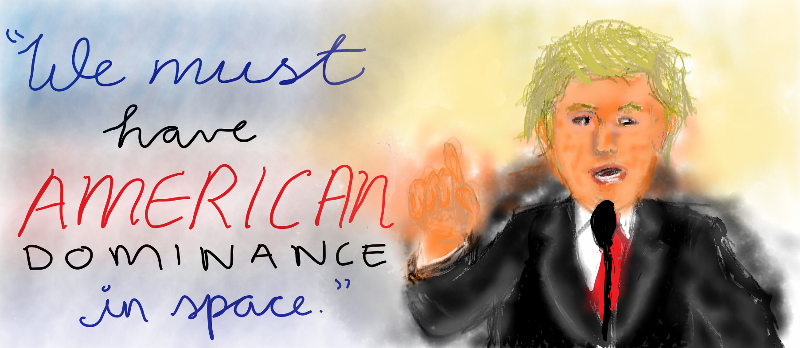18 June 2018: The day President Trump decided to launch a “space force” as a 6th military branch to oversee space operations. Trump’s idea is reckoned as advancement in his perspective, but will embracing this idea create a better society? Enforcing a “space force” will accumulate to a drastic increase in space debris. To understand the impacts of space debris, it is important to understand what it is.
What is space debris? Old, dysfunctional satellites, spent rocket stages, and fragments of their collisions are considered space debris. These objects serve no purpose and are trapped in Earth’s orbit because they are too far away to reenter the Earth’s atmosphere. Most of the space debris accumulates in the low Earth orbit, which is within 2,000 km of Earth’s surface. Other debris is located in the geostationary orbit, about 36,000 km above the Earth’s surface. Objects less than 600 km from the Earth might take several years to reenter the atmosphere, while objects farther away might take centuries to accomplish this. The threat that these minute particles pose for the future of space exploration is devastating.
The rapid accumulation of space debris will restrict space exploration. Millions of objects zooming around at speeds of up to 8 km/second and huge satellites in their orbit are merely ingredients to a catastrophe. Accidental and intentional collisions have contributed to the significant increase in space debris. The 2007 Chinese anti-satellite missile test and the collision between the Iridium 33 and Cosmos 2251 satellites accounted for millions of debris particles. Militarizing space will further escalate the threats of these collisions in space. The “Kessler Syndrome”, proposed by NASA scientist Donald J. Kessler in 1978, states that these series of collisions would make it impossible for us to carry out future space operations. Ironically, trying to make space accessible will make it unsafe. Preventing such huge effects demands action and, fortunately, people do care enough to take action.
A problem of such gravity does have solutions. China, U.S.A., the European Space Agency, and other nations have mitigation to minimize debris. RemoveDEBRIS plans to use nets to capture debris. Operators lower satellite orbits so they naturally return to the atmosphere in 25 years. Electrodynamic tethers can slow down debris and drag them into the atmosphere. Unfortunately, these solutions are expensive. Nobu Okada, the founder and CEO of Astroscale, stated that removing just a single piece of space debris costs over $100 million. My solution is to have alternate launching and “clean-up” periods. Launching periods last for 3 weeks, when only selected “major” explorations will take place. During “clean-up” periods, nations discuss solutions and enforce them.
The increase of space debris is not majorly addressed in today’s society. Without legitimate solutions, the problem will worsen. Although this cannot be solved without rich, powerful people, a common man can spread awareness and propose solutions to these influential and powerful people. We should not only save the Earth, but also the universe around us.
About the Author:
Shaunak Roy is a 9th grader aspiring to make a difference in today’s society through his education and academic interests. This academic disposition does not hinder him from reaching out to various non-academic hobbies. He is a former club cricket player, he is an aspiring urban/hip-hop dancer, and he also adores indulging in other forms of sports and arts.
